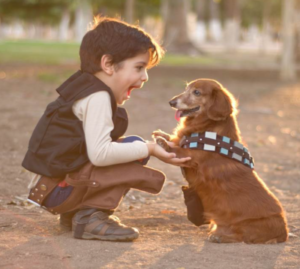 Best Dog Breeds for Kids
Best Dog Breeds for Kids
Dogs are great for kids. They are not only a great source of unconditional love, but they also teach responsibility. Having a dog simply makes children very happy. The dog that you choose for your kid should be compatible with your family to ensure a smooth transition and a happy life for both the kid and the dog. Before diving into the list of best dog breeds for kids, let’s discuss some of the factors to consider when choosing a pup for your child.
Factors to Consider when Choosing the Best Dog Breed for Kids
- Size
The size of the dog dictates how much space they will require. If you have an over-sized backyard, a large breed dog can be a good option. If you live in an apartment that doesn’t have much space, go for a smaller breed.
- Grooming and shedding
Some dog breeds shed more fur than others. Such breeds need lots of grooming and maintenance. Grooming is both quite costly and time-consuming. If your child is allergic to dog fur, dogs that shed often are not a good choice for them.
Read about air purifiers for pet odor, hair & dander.
- Energy levels.
Dogs have different energy levels despite their age, Dogs that have high energy levels require regular exercises and plenty of physical stimulation so that they remain happy and healthy.
- Expenses
Regardless of the breed of the dog that you choose for your child, you will have to incur veterinary expenses. Be prepared for several visits to the vet from routine vaccines to unexpected illnesses. Nonetheless, the dog will need food, toys, a leash among other essential items.
- Climate
Some dog breeds adapt better to climatic conditions than others. For instance, a Chihuahua does well in hot climates whereas dogs with heavy fur coats overheat easily. Consider the weather of where you live and what breed will work best in such weather.
- Affordability
The cost of a dog is a lot more than the price you pay for getting the dog. Calculate the cost of the dog’s grooming, food, and healthcare so that you have an idea of what you will actually spend on the dog.
11 Best Dog Breeds for Kids
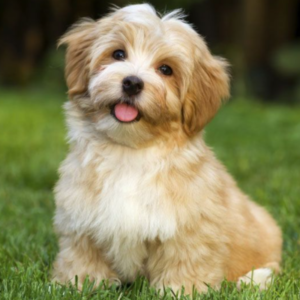
Havanese
This tiny charmer has exuberant personalities and is perfect for your kid. It is social and outgoing. It is also loving and enjoys playing games. If you are looking for a silly, outgoing friend for your child, this is a great choice for you.
General appearance: The dog is slightly long and weighs 7 to 13 dogs. The dog has drop ears and a tail that curls over the back. It has a coat that is straight or wavy.
Nutrition: The dog should be fed 1/2 to 1 cup of high-quality dry food daily divided into two meals. If it is given treats, it should be in moderation.
Grooming: The long, soft, and silky coat of this dog needs to be groomed daily to keep it free of mats and tangles. It should also be bathed occasionally as needed.
Exercise: The dog requires moderate exercise. Never over-exercise a Havanese of any age. 20 to 40 minutes are good for this breed.
Training: The dog is easy to train as long as only positive methods are used. This is because it is highly intelligent and eager to please.
Health: This is a dog breed that is generally healthy and fairly long-lived. But like other dogs, it is prone to certain health conditions. This includes Hip Dysplasia, Elbow Dysplasia, Legg-Perthes Disease, Cataracts, deafness, and Portosystemic shunt.
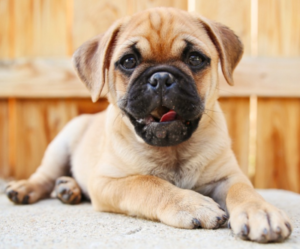
Chug
This is a specific breed comprised of Pug and Chihuahua ancestry. It is one of the best family dogs. Chug is characterized by intelligence, affection, loyalty, and loves to play. It is a designer dog whose characteristics vary from liter to liter.
General appearance: The dog has a smooth and short coat. It is a small dog that weighs up to 9kg and is generally 6 to 12 inches tall. It has almond-shaped eyes, a short muzzle, and floppy ears.
Nutrition: The dog needs high-quality commercial dog food that is made for his unique needs. Ensure that you choose kibble that uses natural high-grade ingredients and has a good ratio of protein to carbs. Usually, the dog needs about a cup of kibble each day divided into two meals to prevent overeating and bloating.
Grooming: Brushing the coat of this dog is necessary as it sheds moderately. Facial wrinkles should be kept clean and dry by wiping them out with a damp cloth and then drying them. This should be done daily, weekly, or monthly depending on the dog’s needs.
Exercise: The dog has low to moderate exercise needs. A 30-minute daily walk and some dedicated periods of active playtime are enough to keep the dog stimulated mentally and physically.
Training: The dog is easy to train as it is smart. However, it is quite stubborn which can make training difficult. To succeed in its training, begin as early as possible, keeping training sessions regular, short and fun.
Health: The dog has a generally healthy life, with a lifespan of 10 to 13 years. However, the dog is susceptible to health conditions such as cataracts, entropion, obesity, and patellar luxation.
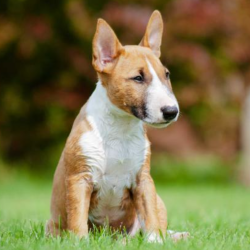 Bull Terrier
Bull Terrier
This is one of the best dogs for kids that are at an older age. It is sweet beyond relief, very protective of the owner, and very trainable. Bull Terrier is charming, mischievous, and playful. It needs a lot of exercises and a lot of love due to its silly, comical antics and crowd-pleasing behavior.
General appearance: The dog has a strong and muscular appearance. It has a distinctive head shape with a long, deep muzzle. It has a muscular, arched, and fairly long neck leading to strong, wide, and sloping shoulders.
Nutrition: The dog should be fed 1 5/8 to 4 1/4 cups of high-quality dog food, divided into two meals.
Grooming: The dog has a short, shiny, and dense coat that is flat. It is very easy to care for hence minimal brushing is more than enough to keep it in good condition.
Exercise: The dog requires an hour to an hour and a half of walking daily.
Training: The dog may not be the easiest to train as much as it is intelligent as it is sometimes stubborn and mischievous. A consistent training regime with plenty of patience from a young age is vital to ensure good behavior.
Health: The dog has an expected lifespan of around 10 to 12 years. It is susceptible to conditions such as Aortic Stenosis, kidney conditions, deafness, allergies, and Patellar Luxation.
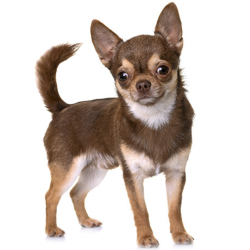 Chihuahua
Chihuahua
This is the tiniest of all dog breeds. It tends to adore children and is very loyal to its family. It is very easy to train and loves the lap of the person who loves them best. Chihuahua loves the indoors and is not fond of very cold weather, maybe because it is originally from Mexico.
General appearance: The dog has an apple-shaped head with a short, pointed snout and round dark eyes. It has bat-like ears. It is tail high and curved and is up to 30 cm tall.`
Nutrition: The dog should be fed a daily amount of 1/4 to 1/2 cups of high-quality dry food.
Grooming: The dog should be brushed weekly. With regular brushing, it shouldn’t need a bath more than every month or two.
Exercise: The dog loves to run and play and can get enough exercise in a very small space. Trotting around is simple enough for this happy breed.
Training: The dog responds well to positive training practices as it is highly intelligent.
Health: The dog doesn’t have any major health problems, but like all breeds, she is susceptible to certain conditions. This includes Patellar luxation, hypoglycemia, pulmonic stenosis, collapsed trachea, and open fontanel.
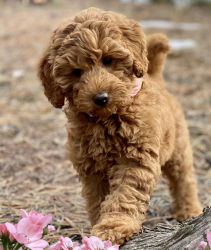 Labradoodle
Labradoodle
This is an adorable, medium-shedder that was originally bred to be empathetic and even-keeled so that it can be trained as a guide dog for people who are visually impaired. It is also affectionate. The dog requires a lot of exercise and tends to greatly get along with other dogs.
General appearance: This dog weighs 22 to 25 inches and weighs up to 75 pounds. The dog may have three different types of hair: straight, wavy, or curly. The coat may vary from a bit wirier to soft.
Nutrition: The dog should be fed 1 to 2.5 cups of high-quality dry food each day, which is divided into two meals.
Grooming: Brushing the coat once or twice per week depending on the type of coat will keep its hair and coat looking good. Ear cleaning and nail clipping should also be done regularly.
Exercise: The dog requires at least half an hour of exercise every day.
Training: The dog is easy to train as it is eager to please. Training sessions should be done every day and kept short.
Health: The dog may live up to 14 years but is prone to some diseases such as hip dysplasia, elbow dysplasia, hypothyroidism, and Addison’s disease.
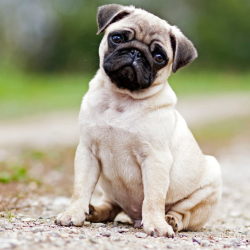 Pug
Pug
This is a popular pup for kids who prefer gentle play to roughhouse. The pooch is playful and was bred to be a lap dog and it adores being around people. It is a great family pet and is clever and quiet.
General appearance: The dog has a short, smooth coat that is shiny and glossy. It has black markings around the muzzle and eyes. It is small-sized and weighs between 6 to 8 kg and is square and muscular.
Nutrition: The dog should have 1/2 to 1 cup of dry food that is of high quality each day, divided into two meals.
Grooming: Its short, fine coat can be easily maintained with occasional brushing at home. Brushing should be enough to remove hair as it is a medium shedder.
Exercise: About an hour of walking a day is enough to keep this dog healthy and happy as it is not especially active.
Training: The dog can be a bit difficult to train as it is stubborn. It is important to start training at an early age with a persistent and determined approach.
Health: The dog can suffer from health problems such as proptosis, entropion, hip dysplasia, obesity, and birthing issues.
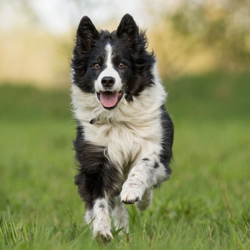 Collie
Collie
Whether rough or smooth, coolies are one of the best dogs for kids. Rough coolies are known for their flowing and majestic coats. On the other hand, smooth coolies have shorter coats. However, rough coolies need more grooming. This is a dog breed that is very intelligent and likes nothing better than to engage in activities with kids. It is very protective of its family, loyal, and is also a fast learner.
General appearance: This is a medium-sized dog that has a characteristic ruff around its neck, underskirt on the abdomen, and feathers on its legs. It has a light head, parallel head planes, and a well-rounded muzzle.
Nutrition: Feed the dog 2 to 3 cups of high-quality dry food every day and divide it into two meals.
Grooming: For the rough Collie, brushing two times a week is recommended to keep its hair looking good. For the Smooth Collie, weekly brushing is good.
Exercise: The dog requires daily exercise as it is an active dog. A daily, fast-moving walk and some playtime will keep up with its exercise needs.
Training: The dog is easy to train, even though it can be resentful to harsh treatment and is sensitive to correction. It should therefore be trained gently.
Health: The dog has a lifespan that ranges between 12 and 15 years. It may be prone to health conditions such as bloat, hip dysplasia, epilepsy, and Collie Eye Anomaly.
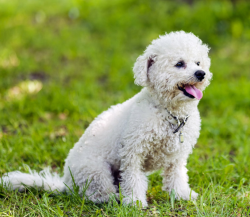 Bichon Frise
Bichon Frise
This little bundle of joy is one of the friendliest dogs on the planet and one of the best breeds for families. It is a low shedder, affectionate, playful, sweet, and a fantastic playmate for energetic kids. The dog is a great city dog due to its small size, as long as gives it lots of walks. It does best with training that is consistent and moderate amounts of activity.
General appearance: The dog has a neck that is carried high and straight front legs. It has a deep chest. It has a balanced head, appropriate for the body, with a skull that is slightly rounded. Its muzzle is slightly longer than the forehead.
Nutrition: The dog should be fed 1/2 to 1.5 cups of dry food that is of high quality a day in two meals.
Grooming: The dog should be professionally groomed to keep its coat in good condition.
Exercise: The dog has medium energy levels and needs around 45 minutes of walking per day to keep it happy and healthy.
Training: The dog is easy to train as it is intelligent and attentive. It is also keen to please and quick to learn.
Health: The dog has a lifespan of about 12 years. It can suffer from conditions such as Patellar luxation, Portosystemic Shunt, Hemolytic Anemia and allergies.
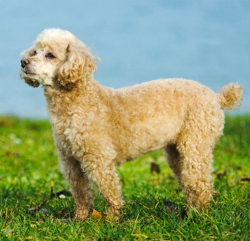 Poodle
Poodle
This is a great choice for kids especially the ones who are allergic. This is because the dog produces fewer allergens. The dog breed comes in three sizes- standard, toy, and miniature. It also comes in multiple colors meaning that you get to choose the color that your kid loves the most. The dog is adorable, easy to train, incredibly smart, adapt well to new environments, and have an immense love for kids.
General appearance: This is a medium-sized dog with an elegant shape. It has a long and fine head with a slight peak with eyes that are dark and almond-shaped. It has long and wide ears. The muzzle is long, straight, and fine. It also has a deep and moderately wide chest.
Nutrition: The dog should be given 1.5 to 3 cups of dry food that is of high quality per day, divided into two meals. It should not be overfed.
Grooming: The dog should be brushed daily or weekly to get rid of entangled dead hair to prevent matting. Its coat should also be clipped regularly to ensure that it is in a manageable state.
Exercise: The dog requires up to 60 minutes of exercise per day as it is energetic. Since it is intelligent, it also enjoys any form of exercise that encourages mental stimulation.
Training: The dog is easy to train as it is mart, eager to please, and versatile. It excels in obedience training and canine sports.
Health: The dog has a lifespan of about 12 years. Like most dogs, it is prone to health problems such as pancreatitis, hip disease, patellar luxation, heart disease, and dental issues.
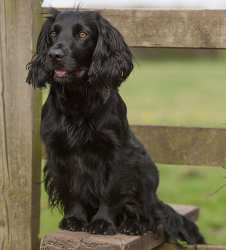 Cocker Spaniel
Cocker Spaniel
This is a gentle, loving, super-smart dog that really enjoys being around children. The pooch tends to always put itself in the middle of the action. It is prone to ear infections as it has ears that are not the only floppy but also beautiful. The dog is, therefore essential to keep it well-groomed and clean. It makes a great therapy dog and maybe a great fit for an anxious child or a special needs child.
General appearance: The dog has a flat, silky, and smooth coat with feathers on its legs and some undercoat for added protection. It weighs about 13 to 14.5 kg. Its neck is of medium length and elbows are held close to the body. The front legs are straight while the muzzle is square-shaped with a wide nose to help follow scents. The eyes are dark.
Nutrition: The dog should be fed 1.5 to 2.5 cups of high-quality dry food per day. Ensure that the dog doesn’t overeat.
Grooming: The dog requires regular brushing to keep the coat at its best and prevent matting. It is also important to clean their ears as they are long and are prone to infections.
Exercise: The dog is energetic hence requires plenty of exercises. It requires around an hour and a half of exercise a day.
Training: The dog is highly trainable as it is intelligent and always eager to please. It also has an attentive nature that makes it to learn quickly and is also generally obedient.
Health: The dog has an average lifespan of 11 to 12 years. Despite being an active dog breed, it is prone to some health problems such as hip dysplasia, Acral Mutilation Syndrome, Hemolytic Anemia, Mammary tumors, and chronic pancreatitis.
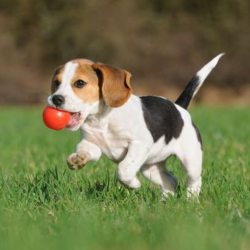 Beagle
Beagle
This is an excellent dog for your kid as it has a compact size, short coat that is easy to care for, and is also intelligent. The dog is also curious, merry, and friendly. Also, it is quick, active, and energetic hence requires plenty of exercises. It is very good with children.
General appearance: The dog has a coat that is short, smooth, and weatherproof. It has a neck that allows it to easily track a scent and a small dewlap and chest that reaches below the elbow. The front legs are straight and strong. It has a level topline, leading to a supple back end that is strong.
Nutrition: The dog should be fed 3/4 to 1.5 cups of high-quality food in two meals.
Grooming: Regular brushing at home is enough to keep its coat clean and healthy. It has fairly long ears that need to be regularly checked for any signs of inflammation or infection.
Exercise: The dog requires around an hour to an hour and a half of exercise per day.
Training: As much as the dog is intelligent, its keen sense of smell makes it prone to distraction hence making training difficult. However, if it picks up a scent, it is normally eager to please and with the appropriate training, it can have a good recall.
Health: This is a generally healthy dog but can suffer from health problems such as epilepsy, Steroid Responsive Meningitis, hip dysplasia, and Primary Open Angle Glaucoma.
Benefits of Kids having a Dog
- Perfect playmate
Not every child is lucky enough to have a sibling to play with while growing up. But, if the child has a lovable companion to play and cuddle with, they will never be lonely.
Related post best tennis ball machines for dogs.
- Personal protection
Dogs provide a child with a sense of comfort and security.
- Little empaths
A child that has grown up with a dog is going to be more empathetic and respectful. A dog is very expressive and shows different emotions such as distress, joy, and fear and your child will learn this from it.
- Lift their spirits
A child is bound to cheer up with one look at that goofy face and into those loving eyes regardless of whether the child is unhappy about something or if she had a bad day.
- Canine confidence
The mere presence of a dog provides incentive and a friend to your toddler to chatter away to, thus giving them a chance to practice their verbal skills. The fact that dogs are patient enough with the toddler gives the child more confidence to keep talking and learning.
Conclusion
Kids usually have an almost-magical connection with dogs as long as it is the right breed. Dogs can even be of great help if the child has anxiety issues. They also teach kids responsibility, cooperation, and compassion while still being the best playmates. To ensure that the dog that you choose for your kid is the best companion, get any of the breeds illustrated above as they are the best there is.
